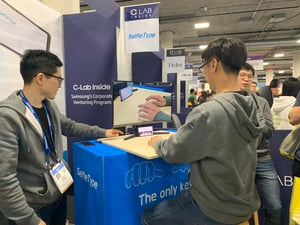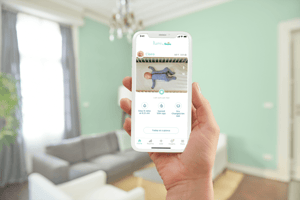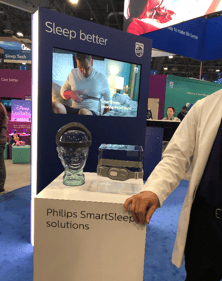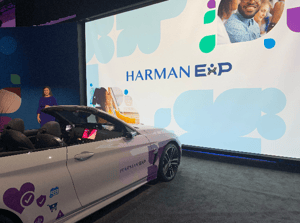Written by
Melissa Lohrer
CES bills itself as the “global stage for innovation,” and its 2020 showing didn’t disappoint. At this year’s Consumer Technology Association conference in Las Vegas, the clarkmcdowall team caught sight of new innovations across the spectrum from rotating televisions to flying taxis.
It all seemed to boil down to this: new tech will make life easier. It’s certainly not a brand new idea, but we’re seeing original interpretations. Gone are the days of creating the shiniest gadget with the most bells and whistles. Today’s tech is all about observing human behaviors and finding a way to step in that’s helpful but not intrusive.
So how is the era of tech unfolding? Here are some of our takeaways.
The future is about adapting to mirror behaviors
Tech companies are making a shift away from teaching us how to interact with devices. Instead, the name of the game is developing tech that mirrors our natural behaviors. The reveal of Samsung C-Lab’s Selfie Type cemented this trend into a looming reality. By enabling users to type on an invisible keyboard using any surface, this new update will make it just as easy to type an email while picking up a quick coffee as it is sitting down at your desk.
The reveal of Samsung C-Lab’s Selfie Type cemented this trend into a looming reality. By enabling users to type on an invisible keyboard using any surface, this new update will make it just as easy to type an email while picking up a quick coffee as it is sitting down at your desk.
The big winners of the future, it seems, will be those that can successfully intuit our organic needs and use tech to make them simple to achieve.
Wearables are stepping up their game
It’s no longer just about counting our steps. Wearables are out to transform the way we make decisions—especially at home.
Lumi by Pampers creates a baby care system for a world where gender roles are giving way to collaborative parenting. Case in point: Lumi by Pampers is creating an all-in-one connected baby care system that’s transforming relationships between parents and their newborns.
Case in point: Lumi by Pampers is creating an all-in-one connected baby care system that’s transforming relationships between parents and their newborns.
It’s not just about getting a notification for wet diapers (though that’s part of it). In a world where traditional gender roles are gradually giving way to a more collaborative parenting approach, realtime information helps parents work together to make informed decisions. Habit tracking will make it easier to share information with allies like pediatricians, assisting them to develop routines for happy babies.
It’s time to maximize sleep performance Many of us are already using tech to track sleep habits, but soon we can expect to use it to truly optimize the 30% of our lives we spend snoozing.
Many of us are already using tech to track sleep habits, but soon we can expect to use it to truly optimize the 30% of our lives we spend snoozing.
Among the new sleep innovations at CES 2020 was a wearable headband from Philips that connects with a smartphone app to optimize your deep sleep and wakes you in the morning during your lighter sleep phases, and a revamped line of Sleep Number mattresses that use temperature technology to create personal microclimates.
Driving is about much more than getting from A to B
From lounge chair seating to smart upholstery, auto manufacturers offered a glimpse of what road travel will look like in the near future. And while there were new innovations of the horsepower and torque variety, much of what we saw came down to the experience of being in a car. From a virtual sunvisor to simplified or enlarged displays to in-car entertainment suites, this year’s new technology was a testament to the transition from driving as a necessity to driving as a full-on experience. We were proud to see first hand our client HARMAN unveil a brand new take on in-vehicle technology - which we partnered to position, name and bring to life. HARMAN ExP is a game changer in the mobility space. Instead of developing and selling individual, silo'ed technologies (connectivity, automation, sound, etc), Harman ExP starts with the end consumer and delivers bundled packages that take safety, enjoyment, wellness and productivity to a whole new level. It’s no longer about seeing how many technology features can be embedded in a vehicle, it’s about improving people’s total experience in the car… making time in the car, time well spent.
We were proud to see first hand our client HARMAN unveil a brand new take on in-vehicle technology - which we partnered to position, name and bring to life. HARMAN ExP is a game changer in the mobility space. Instead of developing and selling individual, silo'ed technologies (connectivity, automation, sound, etc), Harman ExP starts with the end consumer and delivers bundled packages that take safety, enjoyment, wellness and productivity to a whole new level. It’s no longer about seeing how many technology features can be embedded in a vehicle, it’s about improving people’s total experience in the car… making time in the car, time well spent.
Virtual reality is evolving
In a keynote speech, Delta unveiled its new PARALLEL REALITY™ tech, bound to change the way we experience airport travel. Each individual looking at one single screen will see their own customized message including flight information and directions to their gate. The goal? To “reduce stress and create engaging moments in unexpected places.”
This innovation sheds light on the direction that virtual reality is headed in for travel and hospitality brands—less emphasis on the showy amenities, more focus on finding ways to use tech to simplify processes and make guests feel at ease.
Want to stay in the know about the latest in branding in the tech world and beyond? Subscribe to our newsletter.
Sign up for the latest news and views
